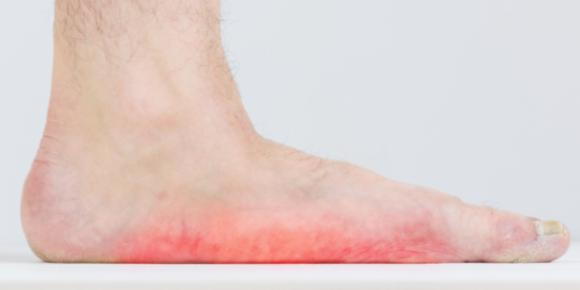Arch Disorders
posted: Apr. 22, 2020.

The arches of the feet play a role in supporting your body’s weight when standing or in motion. The tarsal and metatarsal bones make up the arches of the feet and receive additional support and stability from tendons and ligaments. However, our feet, like the rest of our body, can be affected by infections, disorders, and structural changes that can impact foot health and mobility. It’s important to recognize the warning signs of arch problems, so you know when you need to see a chiropodist.
Why do I have Arch Pain?
If you are dealing with arch pain, it is most likely caused by an injury or by structural abnormalities in the foot. For example, those with very high arches, as well as those with flat feet may experience arch problems due to these common structural issues.
As a result, other factors could also lead to further arch problems, including:
- High body mass index
- Plantar fasciitis
- Cavus foot
- Navicular fracture
- Posterior tibial tendon dysfunction
- Increased activity
- Unsupportive shoes
It’s important to understand a little bit more about these common foot disorders and how they could affect the arches of your feet.
High Body Mass Index
An increase in weight or being overweight can add additional stress to feet that already have poor biomechanics. This address stress can lead to pain and discomfort in the arch and other areas of the feet.
Plantar fasciitis
This condition that causes inflammation and microtears in the plantar fascia is also the most common cause of heel pain. Of course, because the plantar fascia (a ligament that connects the toes to the heel bone) also supports the arches of the feet, this can also lead to arch pain. This condition is usually the result of overuse and is seen most often in runners. If you have plantar fasciitis, it’s important to avoid physical activities until the fascia has fully healed.
Cavus foot
This condition, which affects the structure of the foot, leads to excessively high arches. People who’ve had a stroke, as well as people with certain conditions such as cerebral palsy, may be more likely to develop cavus foot. This problem causes arch pain when standing or walking and can increase the risk of ankle injuries. Your chiropodist may choose to treat cavus foot through custom-made orthotics (shoe inserts), bracing, or by recommending specialized and supportive footwear.
Posterior Tibial Tendon Dysfunction (PTTD)
The posterior tibial tendon runs from the calf muscles to the inner portion of the foot. A dysfunction or weakening of the tendon reduces its ability to support the foot. Flat feet are often a result of posterior tibial tendon dysfunction, also known as ‘adult acquired flat foot.’ Like the other conditions above, treatment for PTTD usually involves bracing, orthotics, or providing custom devices that provide additional support to the arches of the feet.
Increased Activity
Many foot and ankle pain, including arch pain, begins when becoming more active, especially after a long period of inactivity. Ensure that you progressively work slowly towards your activity goals to get your feet and arches adapted to the new activity.
Unsupportive Shoes
Using shoes that fail to provide adequate support with activity (e.g. sports, running) may lead to pain and discomfort in the arch. A Chiropodist can recommend appropriate shoes based on your feet and lifestyle.
When should I see a Chiropodist?
If you are experiencing foot pain, swelling or other problems that affect mobility, then it’s time that you turned to a chiropodist for care. Conditions and injuries that don’t respond to rest and home care may require more advanced treatments and therapies.
